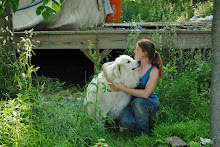One of the best and simultaneously most challenging aspects of farming is that I am forever discovering new avenues of exploration about which I know...nothing. In honor of that fact, here's a list of some interesting tidbits I've lately accumulated. Now if I could only retain all of this, and not have it leak out my ears like so much that I've learned over the years.
- If you scout your onion bed the day after transplanting, you are liable to notice that a number of young onion transplants have been pulled up out of the soil. It will look like a random act of farm vandalism in miniature. In fact, it is worms. A nearby farmer got fed up with this mysterious annual phenomenon and sat out one night with a flashlight until he caught the little fertilizers popping up for a spot of night air and knocking the onions out of the soil. Solution: thank your lucky stars that you have so many worms in your soil and always keep a few transplants set aside as replacements.
- Even after a year of nursing, young calves will bellow as though the sky is falling when you separate them from their mamas. Also, cows only need about one hour of sleep daily. That leaves a lot of time for plaintive mooing.
- Building a hoophouse is harder than it looks. Disassembling a hoophouse is easy. Rebuilding a disassembled hoophouse is an endeavor fit only for someone with the strength of Paul Bunyan and the patience of Gandhi.
- I will probably never become a dandelion wine aficionado, as the manufacture of this intriguing beverage requires you to first de-petal a gallon's worth of dandelions. Then you've got to ferment your brew for upwards of a year. There are limits even to my DIY ethic.
- Chocolate mint (the plant) really does taste like a junior mint. Whoa.
My mead experiment is coming along nicely: I just put it in a gallon jug (one of those cool looking ones that you half expect to be labeled with "XXX") with an airlock and tucked it away to ferment. I'll share with you what I've done thus far, and I encourage you to give it a try. Mead is delightfully low-tech, and requires absolutely no de-petaling.
Basic T'ej (Ethiopean Honey Wine, or Mead)
Ingredients:
3 cups honey (try to get unprocessed, raw honey for flavor and health benefits)
12 cups (3 liters) water, unchlorinated is best
Equipment:
1 gallon bucket or crock, wide mouth
1 gallon glass jug (like you would expect moonshine or apple cider to come in, with a narrow neck)
airlock (they cost about $1 at most homebrew stores), or a balloon
Mix your honey and water in the wide mouth container until the honey is fully dissolved. Cover with a towel or cloth and set it in a warm place. You want the natural yeast in the air to be able to enter the mixture, but want to keep our dirt, bugs, etc.
Several times a day, as you think of it, stir the honey water. After several days (in my case it took nearly a week) your brew should begin to bubble slightly and acquire a faintly fermenty aroma. At this point, transfer it into the small mouth container and either stop it with the airlock or cover the neck with a balloon. The goal here is to allow carbon dioxide (the waste product of the yeast as it transforms sugar into alcohol) to escape, but to prevent any new airborn yeasts from joining the party.
Now let your mead ferment for 2-4 weeks, until the bubbling slows down. Sandor Katz notes that the flavor will develop the longer you let your mead sit, but that it is perfectly drinkable, not to mention intoxicating, after even such a short ferment. I'm counting down and crossing my fingers!
Basic T'ej (Ethiopean Honey Wine, or Mead)
Ingredients:
3 cups honey (try to get unprocessed, raw honey for flavor and health benefits)
12 cups (3 liters) water, unchlorinated is best
Equipment:
1 gallon bucket or crock, wide mouth
1 gallon glass jug (like you would expect moonshine or apple cider to come in, with a narrow neck)
airlock (they cost about $1 at most homebrew stores), or a balloon
Mix your honey and water in the wide mouth container until the honey is fully dissolved. Cover with a towel or cloth and set it in a warm place. You want the natural yeast in the air to be able to enter the mixture, but want to keep our dirt, bugs, etc.
Several times a day, as you think of it, stir the honey water. After several days (in my case it took nearly a week) your brew should begin to bubble slightly and acquire a faintly fermenty aroma. At this point, transfer it into the small mouth container and either stop it with the airlock or cover the neck with a balloon. The goal here is to allow carbon dioxide (the waste product of the yeast as it transforms sugar into alcohol) to escape, but to prevent any new airborn yeasts from joining the party.
Now let your mead ferment for 2-4 weeks, until the bubbling slows down. Sandor Katz notes that the flavor will develop the longer you let your mead sit, but that it is perfectly drinkable, not to mention intoxicating, after even such a short ferment. I'm counting down and crossing my fingers!




1 comment:
mm... mead. Thanks for posting the recipe, I'd be interested to hear how the final product turns out. I may very well start a batch in time for the summer solstice party...
Post a Comment